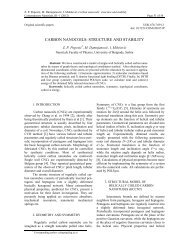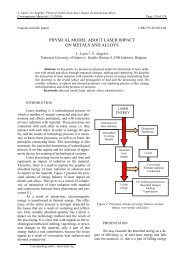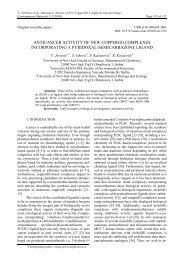physical model about laser impact on metals and alloys
physical model about laser impact on metals and alloys
physical model about laser impact on metals and alloys
You also want an ePaper? Increase the reach of your titles
YUMPU automatically turns print PDFs into web optimized ePapers that Google loves.
L. Lazov, N. Angelov, Physical <str<strong>on</strong>g>model</str<strong>on</strong>g> <str<strong>on</strong>g>about</str<strong>on</strong>g> <str<strong>on</strong>g>laser</str<strong>on</strong>g> <str<strong>on</strong>g>impact</str<strong>on</strong>g> <strong>on</strong> <strong>metals</strong> <strong>and</strong> <strong>alloys</strong>C<strong>on</strong>temporary Materials I−2 (2010) Page 125 of 128which really participates in processing (structuralchanges, melting, vaporizati<strong>on</strong> in the unit volume).In certain references it is defined as a percentage ofthe total energy falling <strong>on</strong>to the material, necessaryfor c<strong>on</strong>crete processing [1]. Under certain simplificati<strong>on</strong>s,if we ignore the c<strong>on</strong>diti<strong>on</strong>s of working z<strong>on</strong>e(c<strong>on</strong>vecti<strong>on</strong>, heat radiati<strong>on</strong> <strong>and</strong> thermal c<strong>on</strong>ductivity)we assume that it is energy absorbed by thematerial.INTERACTION OF RADIATIONWITH A SAMPLEThe interacti<strong>on</strong> of <str<strong>on</strong>g>laser</str<strong>on</strong>g> radiati<strong>on</strong> with a sampleis c<strong>on</strong>nected with the level of absorpti<strong>on</strong> А%,which is defined as a percentage of energy absorbedby material from the total energy falling <strong>on</strong>to thematerial. Optical depth of penetrati<strong>on</strong> δ is definedwith absorpti<strong>on</strong> coefficient δ = 1/α. In this case wehave exp<strong>on</strong>ential decrease of radiati<strong>on</strong> intensity withdepth z. For str<strong>on</strong>g absorbing materials, such as <strong>metals</strong><strong>and</strong> <strong>alloys</strong>, the depth of penetrati<strong>on</strong> δ is lowerthan wavelength λ of falling radiati<strong>on</strong>. Total energythat penetrates the material is absorbed <strong>and</strong> it doesnot depend <strong>on</strong> the thickness of the sample [1].The ratio of absorpti<strong>on</strong> according to [2] depends<strong>on</strong>: optical c<strong>on</strong>stants of material - coefficient of reflecti<strong>on</strong>R, absorpti<strong>on</strong> index к / ; <str<strong>on</strong>g>physical</str<strong>on</strong>g> properties of <str<strong>on</strong>g>laser</str<strong>on</strong>g> radiati<strong>on</strong> – wavelengthλ, polarizati<strong>on</strong>, power density q S ; chemical compositi<strong>on</strong> of surface – oxides, nitride,graphite layers <strong>and</strong> so far; topography of surface (roughness);as well as <strong>on</strong> the angle of radiati<strong>on</strong> falling, temperature<strong>and</strong> aggregate state of material which is under<str<strong>on</strong>g>impact</str<strong>on</strong>g>.The dependence of absorpti<strong>on</strong> ability А <strong>on</strong>wavelength λ for different materials at room temperature<strong>and</strong> angle of falling 0 o (towards normal) to thesurface is presented in Fig. 2 [3].We can see from the graph that absorpti<strong>on</strong>ability (except for Аl) decreases with an increase ofwavelength. Differences in separate groups of metalwhich are under <str<strong>on</strong>g>laser</str<strong>on</strong>g> <str<strong>on</strong>g>impact</str<strong>on</strong>g> are clearly noticeable.Thus, for example, for precious <strong>metals</strong> (Ag, Cu) absorpti<strong>on</strong>decreases very fast for wavelengths fromvisible spectrum, <strong>and</strong> for transiti<strong>on</strong> <strong>metals</strong> (Fe, Mo)the absorpti<strong>on</strong> change is more smooth <strong>and</strong> exp<strong>and</strong>sto the far infra-red range. Аl, which is a representativeof polyvalent <strong>metals</strong>, has specific change of absorpti<strong>on</strong>with medium maximum for wavelength λ =0,84 µm <strong>and</strong> almost for total range of wave lengthsit has low absorpti<strong>on</strong> [1]. We can see <strong>on</strong> the graphfor industry used <str<strong>on</strong>g>laser</str<strong>on</strong>g>s that there are great differencesc<strong>on</strong>cerning the ratio of absorpti<strong>on</strong> for different<strong>metals</strong>. For example, ir<strong>on</strong> (Fe) under <str<strong>on</strong>g>impact</str<strong>on</strong>g> fromCO 2 -<str<strong>on</strong>g>laser</str<strong>on</strong>g> <strong>and</strong> Nd:YAG <str<strong>on</strong>g>laser</str<strong>on</strong>g> has absorpti<strong>on</strong> capabilitywhich changes 4 times <strong>and</strong> for Аl this differenceis insignificant. If we compare the ratio of absorpti<strong>on</strong>for Аl under <str<strong>on</strong>g>impact</str<strong>on</strong>g> of diode <str<strong>on</strong>g>laser</str<strong>on</strong>g>s (λ = 0,808 -0,940 µm) <strong>and</strong> Nd:YAG <str<strong>on</strong>g>laser</str<strong>on</strong>g>s, the diode <strong>on</strong>es havepriority over others. The temperature of surfacewhich is under processing is very important for increasingabsorpti<strong>on</strong> of <str<strong>on</strong>g>laser</str<strong>on</strong>g> radiati<strong>on</strong> falling <strong>on</strong> thematerial. This is easy to see in Fig. 3. If we reach themelting point then the absorpti<strong>on</strong> ability changes rapidly.This effect is noticed for Аl with different <str<strong>on</strong>g>laser</str<strong>on</strong>g>sources - CO 2 -<str<strong>on</strong>g>laser</str<strong>on</strong>g>, Nd:YAG <str<strong>on</strong>g>laser</str<strong>on</strong>g> <strong>and</strong> diode <str<strong>on</strong>g>laser</str<strong>on</strong>g>.For <str<strong>on</strong>g>laser</str<strong>on</strong>g>s with shorter wavelength that jump issignificant comparing to CO 2 -<str<strong>on</strong>g>laser</str<strong>on</strong>g>. Other variables,which <str<strong>on</strong>g>impact</str<strong>on</strong>g> absorpti<strong>on</strong>, are polarizati<strong>on</strong> <strong>and</strong> angleof falling of the <str<strong>on</strong>g>laser</str<strong>on</strong>g> beam. (For <str<strong>on</strong>g>laser</str<strong>on</strong>g> radiati<strong>on</strong> <str<strong>on</strong>g>impact</str<strong>on</strong>g>s,we have clearly expressed maximum forBrewster’s angle, if electric vector E vibrates parallelto surface of falling. As for the <str<strong>on</strong>g>impact</str<strong>on</strong>g> with polarized<str<strong>on</strong>g>laser</str<strong>on</strong>g> radiati<strong>on</strong>, if electric vector E vibratesnormally to plane of falling we observe a smooth increaseof absorpti<strong>on</strong> (see fig. 4). Nature of absorpti<strong>on</strong>maximum depends <strong>on</strong> wavelength λ. For λ = 10,6µm the maximum is narrow <strong>and</strong> has a value of <str<strong>on</strong>g>about</str<strong>on</strong>g>80%, <strong>and</strong> for visible range it is wide <strong>and</strong> <str<strong>on</strong>g>about</str<strong>on</strong>g> 30%.The above effects are valid at low power density thatdoes not allow creati<strong>on</strong> of plasma–cloud over theprocessing surface.Figure 2. How absorpti<strong>on</strong> ability А depends <strong>on</strong>wavelength λ for different <strong>metals</strong> <strong>and</strong> steel at roomtemperature <strong>and</strong> angle of falling al<strong>on</strong>g normally to thesurface







